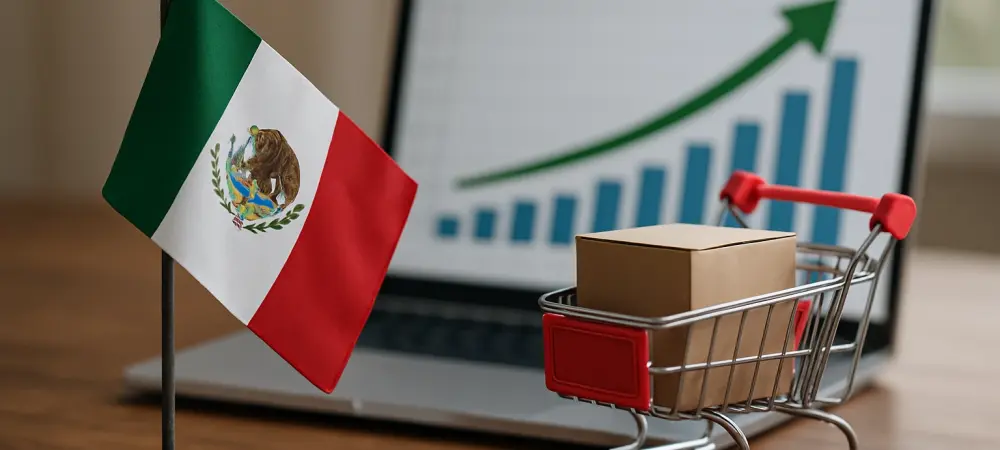What if a single market could transform the trajectory of a U.S. retail business with millions of eager online shoppers ready to buy? Mexico, with its staggering 80 million digital consumers, stands as a goldmine for American e-tailers in 2025. The explosive growth of e-commerce south of the border isn’t just a trend—it’s a seismic shift that’s redefining cross-border trade and opening doors to unprecedented opportunities.
Why Mexico Is the Hottest E-Commerce Frontier
Mexico has cemented its position as the second-largest retail hub in Latin America, boasting an e-commerce revenue that’s soaring to new heights. Current estimates peg the market’s value at $63 billion in 2025, with mobile commerce alone contributing a hefty share and projected to climb even further by 2027. This isn’t just about numbers; it’s about a cultural pivot toward digital shopping, driven by widespread smartphone adoption and a hunger for U.S. brands.
The appeal for American retailers lies in the unique demand dynamics. A striking 45% of Mexican online shoppers already purchase internationally, with many favoring products from north of the border. This preference creates a ripe environment for businesses ready to navigate the landscape, especially those armed with the right tools and insights to meet local expectations.
Decoding the Digital Shopping Boom South of the Border
Behind the impressive statistics lies a vibrant, evolving consumer base. Mobile shopping dominates the scene, with transactions via smartphones making up a significant chunk of e-commerce activity. Projections suggest mobile commerce will hit $43.4 billion by 2026, reflecting how deeply embedded these devices are in daily life across Mexico.
This digital shift isn’t happening in isolation. Infrastructure improvements and increasing internet access have fueled the rise, particularly among younger demographics who prioritize convenience and variety. For U.S. retailers, understanding this mobile-first mindset is critical to crafting strategies that resonate with a tech-savvy audience eager for seamless experiences.
Inside a Game-Changing Resource for U.S. Retailers
A newly released e-book by a leading logistics provider offers a deep dive into conquering Mexico’s e-commerce market. This comprehensive guide unpacks the nuances of shopper behavior, revealing why Mexican consumers gravitate toward American brands and rely heavily on mobile platforms for purchases. It’s a treasure trove of data-driven insights for businesses looking to make their mark.
Logistics challenges, often a stumbling block in cross-border trade, are tackled head-on in the resource. From navigating customs compliance like RFC tax ID requirements to decoding Mexico’s complex address formats, the guide provides clarity on operational hurdles. It also spotlights innovative shipping solutions, such as a prepaid duty service ensuring fast, trackable deliveries that enhance customer satisfaction.
Transparency in delivery emerges as a non-negotiable factor. The guide emphasizes how real-time tracking and reliable transit times build trust with Mexican buyers. “Delivery isn’t just about getting a package to the door—it’s about creating confidence in every step of the journey,” notes an industry expert, underscoring the importance of dependable logistics in this market.
Strategies That Win in Mexico’s Competitive Market
Success in Mexico demands more than just a great product; it requires a tailored approach rooted in local preferences. Industry insights reveal that dependable shipping is the cornerstone of customer loyalty, with delays or lack of updates often derailing trust. The guide offers actionable advice on avoiding these pitfalls, drawing from real-world examples of U.S. retailers who’ve thrived by prioritizing delivery excellence.
One notable case study highlights a mid-sized American apparel brand that doubled its Mexican sales within a year. Their secret? Streamlined shipping processes and a focus on transparent communication with customers. Such stories illustrate how strategic planning can transform logistical challenges into competitive edges, providing a blueprint for others to follow.
Cultural nuances also play a pivotal role. Adapting marketing messages to reflect local values and ensuring product offerings align with regional tastes can set a brand apart. This blend of operational and cultural savvy, as detailed in the resource, equips retailers to stand out in a crowded digital marketplace.
Your Roadmap to E-Commerce Success in Mexico
Taking the plunge into Mexico’s market starts with a clear plan, and the e-book lays out practical steps to get started. First, analyzing consumer trends is essential—data on shopping habits can shape product selections and promotional tactics to match local demand. This targeted approach ensures relevance in a diverse market.
Next, optimizing shipping is a must. Services offering fast, trackable deliveries with prepaid duties simplify the process and build credibility with customers. Additionally, mastering compliance hurdles, from customs paperwork to address formatting, prevents costly delays and ensures smooth operations across borders.
Finally, accessing this free resource is a no-brainer for any retailer eyeing expansion. The guide serves as a complete toolkit, synthesizing critical insights and solutions into an easy-to-follow framework. It’s a stepping stone for businesses ready to capitalize on one of Latin America’s most dynamic markets, providing the confidence to navigate uncharted territory.
Reflecting on a Transformative Journey
Looking back, the journey into Mexico’s e-commerce landscape revealed a market brimming with potential for those who adapted swiftly. The blend of skyrocketing digital adoption and a clear demand for U.S. products painted a picture of opportunity that many American retailers seized with gusto. Their stories of growth underscored a vital truth: preparation was everything.
Beyond past achievements, the path forward demanded innovation in logistics and a deeper grasp of local consumer quirks. Retailers who invested in robust shipping solutions and cultural alignment often found themselves ahead of the curve. For those still on the sidelines, the next step was clear—leverage comprehensive resources to turn Mexico’s digital boom into lasting success.

